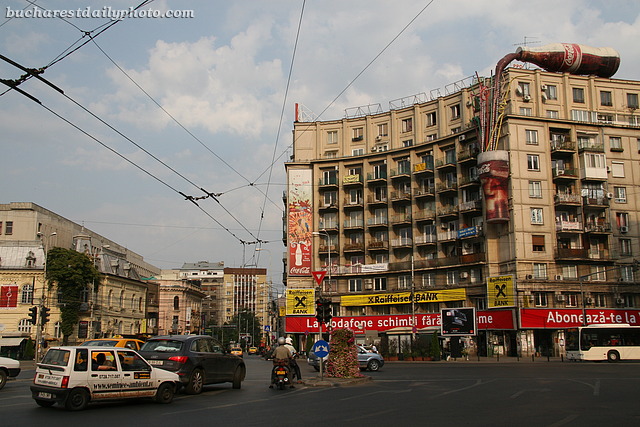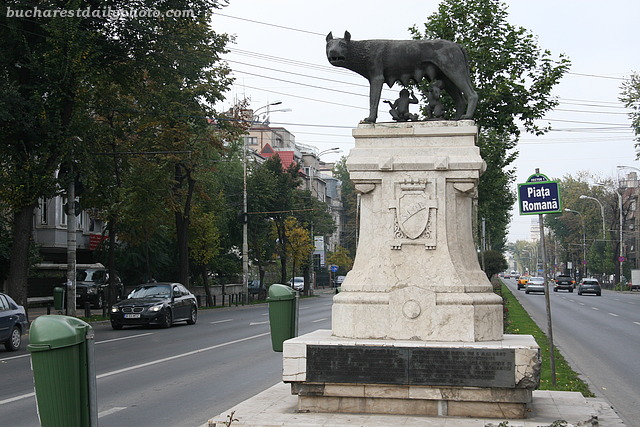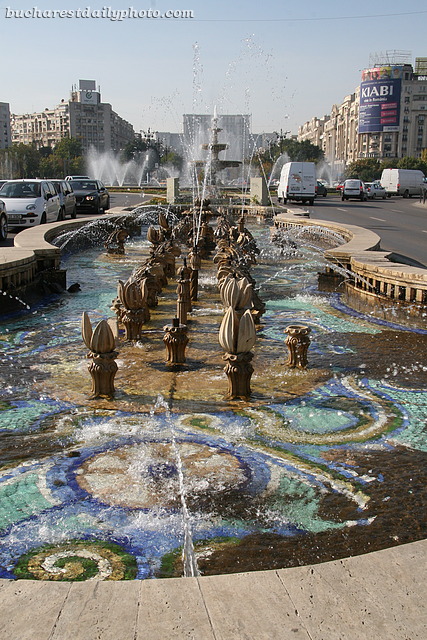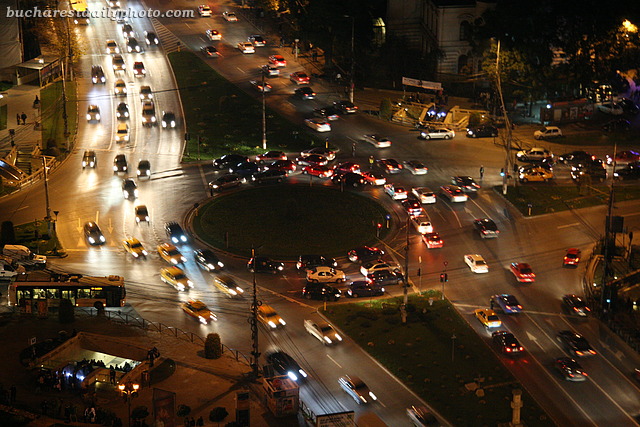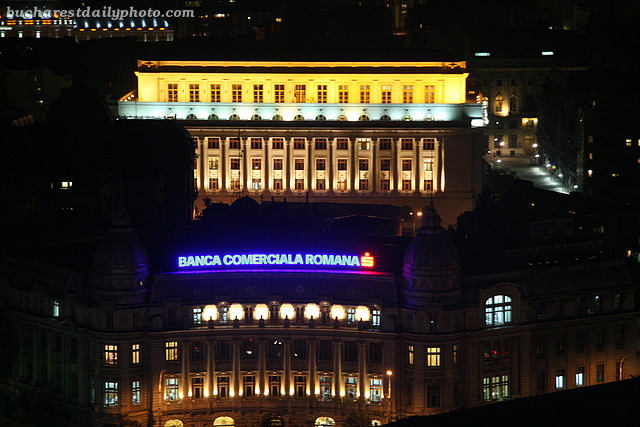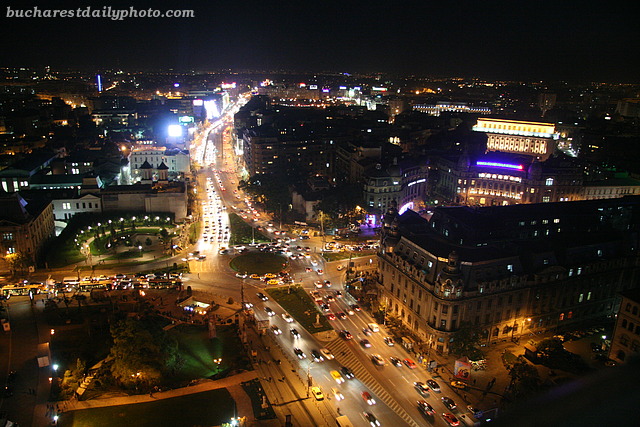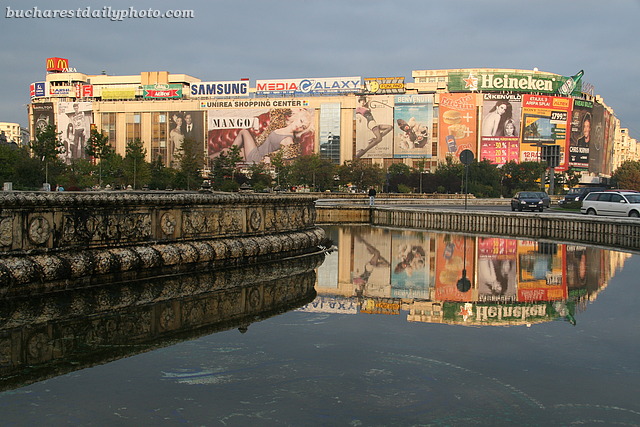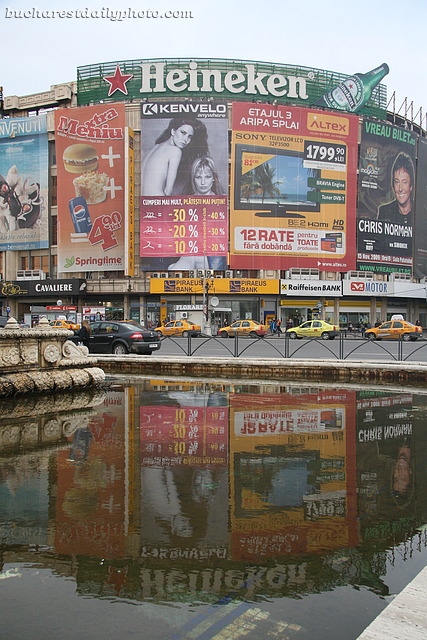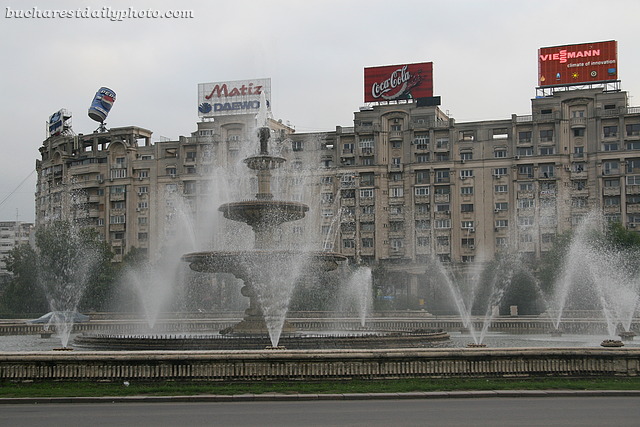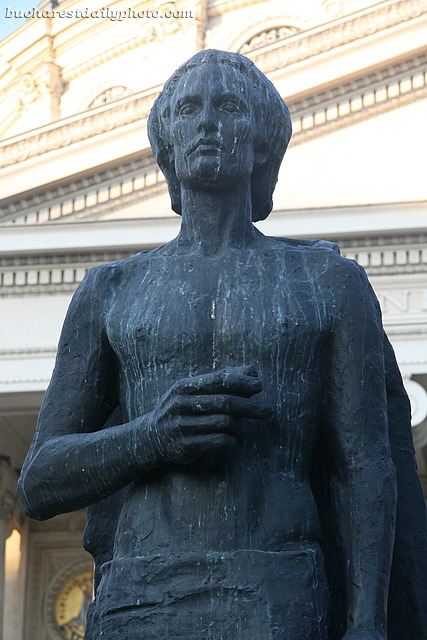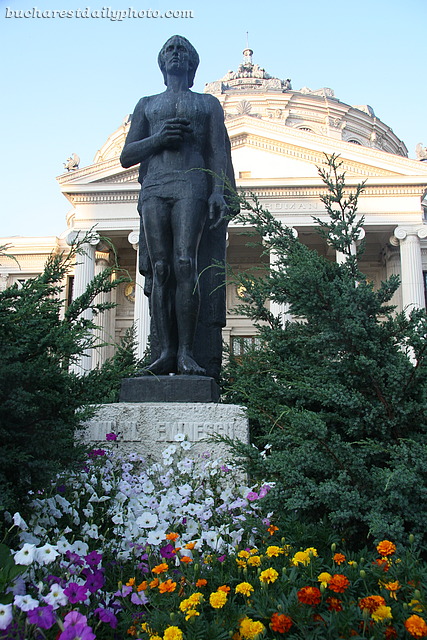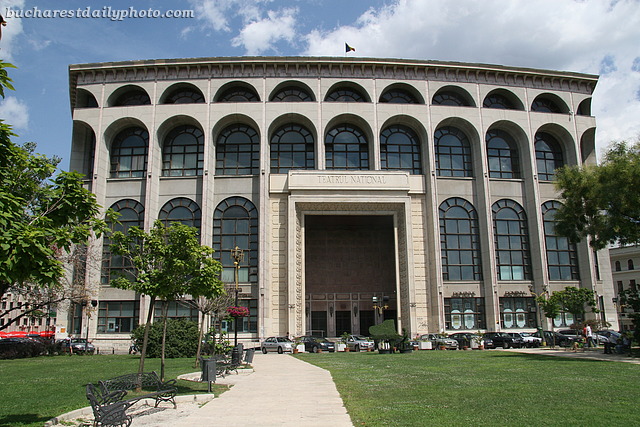For today, a photograph from the Roman Square, (Piaţa Romană in Romanian) which I mentioned in the She Wolf post last week. The Roman Square is a major traffic intersection in downtown Bucharest. Set around 1900, the square has a circular shape and a big roundabout. Three major boulevards intersect here. What you see in the picture is the southeast corner. The square is served by a subway station and is a major transport hub for buses and taxis. The huge Coca Cola bottle pouring into a glass stuck to the side of the building has been there for more than two years (if I remember correctly). I took the picture at the beginning of September. It will be some time before we see a sky so blue again.
I guess most of you are familiar with the famous statue of the Capitoline Wolf, the symbol of the founding of Rome. The statue depicts the twin brothers Romulus and Remus suckling on a she wolf. The original sits in Museo Nuovo in the Palazzo dei Conservatori on Rome’s Campidoglio. There is still a debate going on regarding its attribution and dating. I can’t help the debate regarding the origin of Rome’s Capitoline Wolf, but I think I can tell you where Bucharest’s She Wolf (Lupoaica in Romanian) came from. This statue was a gift from the city of Rome given to Bucharest in 1906 with the occasion of the “General Exhibition of Romania” (also named “Jubilee National Exhibition”) which marked three events: 40 years since the crowning of King Carol I as the ruler of Romania, 25 years since the Proclamation of Independence by the Romanian Kingdom, and 1,800 years since the emperor Trajan’s colonization of Dacia (current day Romania) in 106. The exhibition, modelled after the World Fair that took place in Paris in 1900, was located in Carol I Park and was intended to show the progresses made by Romania in different areas: politics, culture etc. The statue was first displayed at the Roman Arenas in Carol Park. After this short moment of glory, the poor She Wolf was moved from one place to another, all around Bucharest. From the Roman Arenas the statue was taken to St. George Square (Piaţa Sfântul Gheorghe in Romanian) only to be relocated again on the Metropolitan Church Hill in 1931. While there, she was the reason of a little controversy because some inventive mind came up with the idea that the She Wolf has its back to the altar, being totally impolite in that regard. So in 1965 it was moved again to a little park in the Dorobanţi Square. Finally, in 1997 it was brought to its current location, a corner of the Roman Square (Piaţa Romană in Romanian) in downtown Bucharest. But the story doesn’t end here. To top it all off, the mayor of Bucharest announced a few months ago – among some protests – that he is thinking of moving it again by the end of the year, this time close to its original location in St. George Square. But so far the She Wolf still sits in the Roman Square, watching patiently the nightmarish traffic of Bucharest and probably staring at the huge Coca Cola bottle that’s been dominating the square for the last two years.
And since I talked about them last week, here’s one more Union Square fountain shot. This will be the last one in the fountain series. I promise to move on to a new subject tomorrow. If you look closely at the picture you can spot the Palace of Parliament in the background.
And last but not least, and I promise to move on tomorrow 🙂 , a close-up of the University roundabout on a Thursday at 19.30 (7.30 PM).
The series with Bucharest’s night shots continues with a photo of two banks: in the foreground we see the Romanian Commercial Bank, the largest bank in Romania, and in the background the National Bank of Romania, which is the the central bank of the country, the one that controls the exchange and the interest rates, supervises the credit institutions and issues the local currency, banknotes and coins.
Yesterday I took some nightly photos of Bucharest and I will be bombarding you with them the next few days. For today we have the roundabout at the University Square.
In today’s picture we have the Unirea Shopping Center that I mentioned in my yesterday’s post. It was built in 1977, during the communist regime. I tried to remember when was the last time that I saw the facade of this building but I can’t remember. What I can tell you is that for a long time it’s been covered by these huge advertisement panels. And since we have no choice but to cope with this visual pollution, I thought I’ll have some fun with it and took these reflection photos. The building is reflecting in the fountains that I also mentioned yesterday, which as you can see are in dire need of a cleaning.
If you come from the southern part of Bucharest, the Union Square (Piaţa Unirii in Romanian) is where the downtown, the city center starts. Two of Bucharest subway lines intersect here and the square is the site of one of the city’s department stores, Unirea Shopping Center. Unfortunately this place was also Ceauşescu’s playground for experimentation, as the square was caught in his plan for “urbanization” and creation of the ugly soviet style Civic Center. I’ve talked before about the extended demolitions that took place in order to make space for the Civic Center. All the buildings located in and around Unirii Square fell prey to these plans. The Brâncovenesc Hospital (where yours truly was born 🙂 ), the Sfânta Vineri Church, the Sfântul Spiridon Church, the Văcăreşti Monastery and many others historic buildings and monuments as well as lots of private houses were virtually wiped out. Instead of these, The Unirii Square is nowadays surrounded by grim, tenement blocks of the communist era, lined along the Unirii Boulevard which was built during the Communist era under the name of “The Boulevard of the Victory of Socialism” (against Bucharest), and renamed after the Romanian Revolution of 1989. Along the Unirii Boulevard, Ceauşescu’s architects envisioned a series of truly ugly fountains and on a stroll of the area yesterday afternoon I found one of them – the biggest – still working. They are usually being turned off in the cold season.
Mihai Eminescu (January 15, 1850 – June 15, 1889) was a late Romantic poet which is considered to be the most influential Romanian poet and has been crowned by many as “Romania’s national poet”. Studying his poems is required in Romanian language schools and I remember getting one of this poems as subject at my Baccalaureate exam (the high school exit exam). His portrait can be seen everywhere in Romania. He is on the 500 lei bill (leu, plural lei, is the Romanian currency) but since that is the highest denomination Romanian bill, the equivalent of 115 euros or $170 you don’t get to see many of those. Many schools and libraries in Romania are named after him and you can see statues of Eminescu everywhere in Romania – like the one in today’s photo, located in front of the Romanian Athenaeum. A few years ago there was a huge scandal when a few young Romanian writers wrote about their idea of Eminescu and against the official idolized image of the poet.
The theatre season has started in Bucharest. I love the theatre, it’s one of my favourite type of performing arts. That’s maybe because my mother used to take me to the theatre every week, when I was little. For me, the sadness of seeing summer departing is a bit alleviated by the start of the theatre season. In today’s photo we have one of the theatre venues of Bucharest, the National Theatre, a stocky building located in December 21st 1989 Square. It was built in 1973 after plans by a group of Romanian architects. The old building of the National Theater was destroyed during the WWII and that site is now occupied by a hotel. Originally the building had a different facade, but in 1984 it was remodeled and got its present massive shape. The theatre has four performance halls.
The National Theater is named after the Romanian playwright and short-story writer Ion Luca Caragiale (1852-1912). His plays made fun of the politics and politicians and of the Romanian society of that day. For example the play that is considered to be his masterpiece, “A Lost Letter”, written in 1884, describes a provincial government election won by a blackmailer. It’s amazing how his works have the same power today as they did a century ago. Not only that, but I saw one of his plays being performed in California and I was surprized to see how the American public of today can relate to his story written in 1880.
